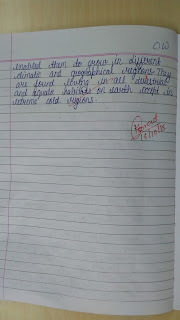REPRODUCTION IN PLANTS
1)What will happen if there will be a day when no trees will
be left on earth?
Ans) No living being will be able to survive, there will be
no rains, therefore no water, therefore no life.
2) How important is therefore the existence of plants on
earth?
Ans) It is the most
important and integral part of earth, which aids the existence of all
the other forms of life.
3) Do you think that
all the plants and trees that we see in our surroundings are the ones that were
born during the origin of earth?
Ans) No
If no, what must have
been the aid for the re-growth of the plants?
Ans)By the means of
seeds, flowers, stem, roots, spores.
-----------------------------------------------------------------------------------------------------------
--Reproduction-
Giving birth to new offspring
-In case of plants, producing new plants is reproduction in
plants.
--In some plants, new plants can be grown with the help of
roots, stems, flowers, fruits, seeds and leaves. This form of reproduction is
called as vegetative reproduction. While most plants reproduce by the means of
seeds.
® Some
plants reproduce by producing spores.
- Among the seed bearing plants, the flowering plants
dominate the non flowering.
PARTS OF THE FLOWER:
Petals: Often
brightly coloured in order to attract birds and insects.
Sepals: Holds the
petals and other parts of the flower.
These are small leaf like structures,
® green in colour
® at the base of the flower
® protects the flower when it is in bud stage
® form an outermost layer calyx
Stamen: Anther
and the filament that holds the anther
® stamen forms the male part of the flower
--The female part of the flower is called as pistil or carpel.
®
Pistil is composed of three parts
Stigma- lies at the
top and is sticky and has coarse surface
® Style- holds the stigma and is hollow tube
that reaches the base of the flower
® Ovary-lies at the base and forms the core of
the flower, tube of the style opens into ovary.
Parts of flower:
à
Stigma
à Style
à Ovary
à Anther
à Filament
à Petal
à Sepal
----------------------------------------------------------------------------------------------------------------------
4) Name the reproductive parts of the flower?
Ans) Pistil and
stamen.
5) What happens to the anther of the flower?
Ans) It is carried to
the stigma of the same or another flower of same type.
6) How is the stigma of the flower useful in the process?
Ans) After the
anther reaches the stigma the anther
moves inside the tube like structure- style of the stigma, in order to reach
the ovary.
7) How does the pollen and the ovary together form the seed?
Ans) The ovule present inside the ovary fuses with the
pollen and fertilisation takes place that gives rise to the seed.
8) What type of pollination is it when the pollen of one
flower is transferred to the stigma of another flower of same type?
Ans) Cross pollination
9) What type of pollination is it when the pollen of the
flower is transferred to the stigma of the same flower?
Ans) Self pollination
------------------------------------------------------------------------------------------------------------------------
Pollination is the
process by which pollen is transferred from the anther to the stigma of the
plant.
----------------------------------------------------------------------------------------------------------------------
The requirements of a seed in order to grow into a healthy
plant:
® right
type of soil
® right amount of water
® oxygen
® sunlight
® temperature
-- After everything is available to the seed in right
proportions, the seed starts developing- this process is called germination.
10) What will happen if the seed is sowed in right kind of
soil?
Ans) It will not grow properly or will not grow at all.
11) What will happen if we over water a plant?
Ans) The soil will
get eroded or the seed will rot and therefore the plant will not grow.
12) What does a seed requires for growing?
Ans) Right kind of soil, right amount of water, right
temperature, oxygen, sunlight
13) What helps in
pollination of a flower?
Ans) Wind, insects, animals.
---Seeds travel to places by natural forces that help them
to reach to distinct places and grow there,
this is called as seed dispersal.
14) Name the seeds shown in the visualiser.
Ans) Coconut, dandelion,
cocklebur, cucumber, apple
15) Which out of the five seeds is the heaviest?
Ans) Coconut
16) Which out of the five seeds is the lightest in weight?
Ans) Dandelion
17 )What is the special characteristic of the cocklebur seed
that makes it different from others?
Ans) It has a rough/
has tiny spine like structures on its surface.
18) How does this special feature of the seed help it in
dispersal by animals?
Ans) It helps the
seed to cling on the animal body.
19) How the hair like
whorl on the dandelion seed helps it to disperse through wind?
Ans) It gives the seed the flight and remain in air, till it
reaches the right place.
20) Where do apples
grow?
Ans )In orchards
21) Do you think that
wind or water dispersal is possible for these seeds?
Ans) NO
Why?
Ans) Wind - because
it is inside the fruit, therefore cannot fly in air, unless open;
Water-
because apples do not grow near water bodies.



























